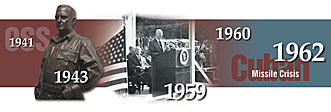| 1941 | 11 July | President Franklin D. Roosevelt appoints William J. Donovan as "Coordinator of Information." Donovan was a prominent lawyer who won the Congressional Medal of Honor as an Army colonel in World War I.
|
| 1942 | 13 June | President Franklin D. Roosevelt signs a military order establishing the Office of Strategic Services (OSS) and naming William J. Donovan as its Director. Donovan remained a civilian until 24 March 1943, when he was appointed brigadier general. He advanced to the rank of major general on 10 November 1944.
|
| 1945 | 1 October | President Harry S. Truman's Executive Order 9621 abolishes the OSS and transfers its functions to the State and War Departments.
|
| 1946 | 22 January | President Truman signs a Presidential Directive establishing the Central Intelligence Group to operate under the direction of the National Intelligence Authority. Truman names the first Director of Central Intelligence, Rear Admiral Sidney W. Souers, USNR, who was sworn in on the following day.
|
| 1947 | 18 September | The National Security Act of 1947 establishes the National Security Council and the Central Intelligence Agency (CIA) to replace the National Intelligence Authority and the Central Intelligence Group.
|
| 1949 | 20 June | The Central Intelligence Agency Act of 1949 provides special administrative authorities and responsibilities for the Agency and the Director.
|
| 1955 | 4 August | President Dwight D. Eisenhower signs a bill authorizing $46 million for construction of a CIA Headquarters Building.
|
| 1956 | 13 January | President Eisenhower establishes the President's Board of Consultants on Foreign Intelligence Activities, predecessor to the President's Foreign Intelligence Advisory Board.
|
| 1959 | 3 November | President Eisenhower presides at laying of cornerstone of CIA Headquarters Building in Langley, Virginia.
|
| 1961 | 17 April | Invasion of Cuba by CIA-supported Cuban exiles at Bay of Pigs.
|
| 20 September | First employees move into CIA Headquarters from various offices in Washington, D.C. area.
|
| 1962 | 15-28 October | The Cuban Missile Crisis, precipitated by the CIA discovery in Cuba of Soviet-made nuclear missiles capable of reaching most of the United States.
|
| 1975 | 4 January | President Gerald R. Ford signs Executive Order 11828 creating the Commission on CIA Activities within the United States. Chaired by Vice President Nelson Rockefeller, the Commission submitted its report on CIA domestic activities to the President on 6 June 1975.
|
| 27 January | The Senate establishes its Select Committee to Study Governmental Operations With Respect to Intelligence Activities under the chairmanship of Senator Frank Church (D-ID). The Church Committee investigated the nation's intelligence activities for 15 months and was disestablished upon submission of its final report to the public on 26 April 1976.
|
| 19 February | The House establishes its Select Com-mittee on Intelligence to investigate allegations of "illegal or improper" activities of federal intelligence agencies. Its first chairman, Representative Lucien Nedzi (D-MI), was later replaced by Representative Otis G. Pike (D-NY). On 29 January 1976, two days before the Committee was scheduled to conclude its activities, the House voted to withhold public dissemination of the Committee's final report.
|
| 1976 | 19 May | The Senate establishes a permanent Select Committee on Intelligence under the chairmanship of Senator Daniel K. Inouye (D-HI) to carry out oversight of the nation's intelligence organizations.
|
| 1977 | 14 July | The House of Representatives establishes a permanent Select Committee on Intelligence. Chaired by Representative Edward P. Boland (D-MA), it differs from the SSCI in that it has oversight jurisdiction over the CIA but shares with several other House committees legislative oversight authority over all other intelligence agencies.
|
| 4 August | President Jimmy Carter announces reorganization of the Intelligence Community, creating a high-level committee chaired by the DCI to set priorities for collecting and producing intelligence, and giving the DCI full control of budget and operational tasking of intelligence collection.
|
| 1978 | 24 January | President Carter signs Executive Order 12036, which reshapes the intelligence structure and provides explicit guidance on all facets of intelligence activities.
|
| 1981 | 20 October | President Reagan reconstitutes the President's Foreign Intelligence Advisory Board and names 19 distinguished citizens outside of government to serve on the Board.
|
| 4 December | President Reagan signs Executive Order 12333, which clarifies ambiguities of previous orders and sets clear goals for the Intelligence Community in accordance with law and regard for the rights of Americans.
|
| 1982 | 23 June | President Reagan signs Public Law 97-200, the Intelligence Identities Protection Act of 1982, imposing criminal penalties on those who reveal the names of covert intelligence personnel.
|
| 1984 | 15 October | President Reagan signs the Central Intelligence Agency Information Act of 1984, which exempts the Agency from the search and review requirements of the Freedom of Information Act with respect to operational and other sensitive files which cannot be released because of operational or security considerations.
|
| 1985 | 1 November | Vice President Bush presides at the laying of the cornerstone for the Headquarters Building Expansion.
|
| 1987 | 27 May | First annual memorial ceremony commemorates Agency employees who have died in the line of duty.
|
| 1991 | March | The New Headquarters Building, attached to the Original Headquarters Building, is completed and occupied.
|
| 1992 | 18 December | Berlin Wall Monument Dedication.
|
| 1996 | 7 June | Memorial Garden Dedication.
|


